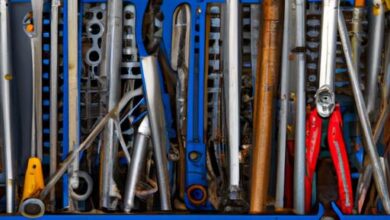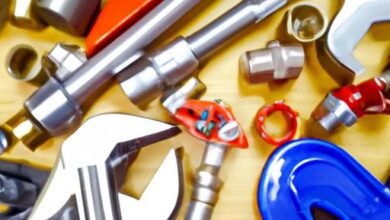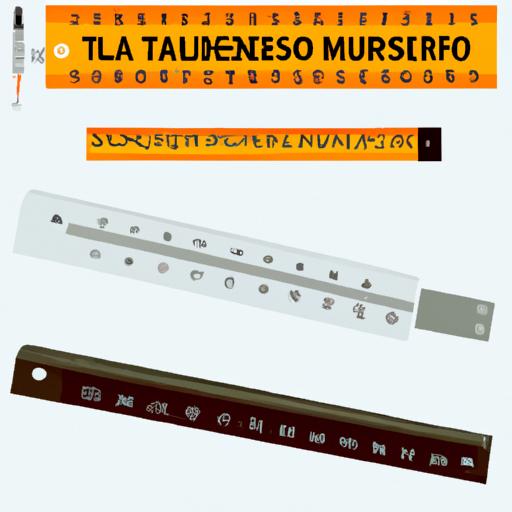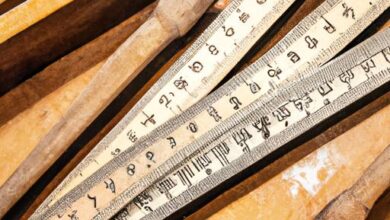Measuring Various Objects Using Nonstandard Measuring Tools Lesson: Unlocking Accurate Measurements with Creativity
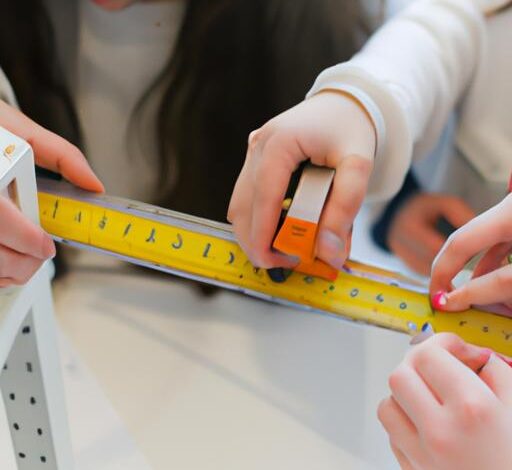
Introduction
How often have you found yourself in a situation where traditional measuring tools just won’t cut it? Whether it’s a uniquely shaped object or an unconventional material, accurately measuring various objects can be quite a challenge. But fear not! In this lesson, we’ll dive into the fascinating world of nonstandard measuring tools. By thinking outside the box and embracing creativity, we’ll discover how these tools can revolutionize the way we measure objects with precision.
Importance of measuring various objects accurately
Accurate measurements are the backbone of numerous fields, from engineering and construction to interior design and cooking. Imagine trying to fit a custom-made piece of furniture into a tight space without accurate measurements – disaster! Precise measurements ensure that objects fit perfectly, reducing the risk of errors, wastage, and costly mistakes.
Introduction to nonstandard measuring tools
So, what exactly are nonstandard measuring tools? Unlike traditional rulers and tape measures, these tools offer unconventional ways to measure objects. We’re talking about everything from string, paperclips, and even your own handspan. These tools allow us to measure objects that defy standard measurements, providing innovative solutions for unique shapes and materials.
Overview of the lesson on measuring various objects using nonstandard measuring tools
In this lesson, we’ll embark on a journey of discovery, learning how to utilize nonstandard measuring tools effectively. We’ll explore their advantages and limitations, and understand why they are essential for measuring specific objects. Through step-by-step guidance and hands-on practice, you’ll gain the skills necessary to measure various objects accurately, even when standard tools fall short.
So, are you ready to unlock the potential of nonstandard measuring tools? Let’s dive in and explore the fascinating world of unconventional measurements!
Understanding Nonstandard Measuring Tools
Definition and Examples of Nonstandard Measuring Tools
When we talk about nonstandard measuring tools, we’re referring to a wide range of unconventional instruments that can be used to measure objects. These tools go beyond the traditional rulers and measuring tapes we’re accustomed to. They allow us to measure objects that are irregularly shaped, have unique dimensions, or are made of unconventional materials.
Nonstandard measuring tools can include everyday objects found around the house, such as string, paperclips, or even coins. For instance, a piece of string can be used to measure the circumference of a circular object, while paperclips can act as makeshift calipers for measuring thickness. The possibilities are endless, limited only by your creativity.
Advantages and Limitations of Nonstandard Measuring Tools
One of the key advantages of nonstandard measuring tools is their versatility. Unlike standard measuring tools, nonstandard tools can adapt to unconventional shapes and materials, allowing for more accurate measurements. They provide flexible solutions for objects that don’t conform to standard measurements, enabling you to measure with precision where traditional tools fall short.
However, it’s important to acknowledge the limitations of nonstandard measuring tools. While they offer innovative ways to measure, they may not always provide the same level of accuracy as standard tools. Nonstandard tools often rely on estimation and approximation, which can introduce a margin of error. Additionally, the consistency of measurements may vary depending on the user’s interpretation and technique.
Importance of Using Nonstandard Measuring Tools for Specific Objects
Nonstandard measuring tools are particularly valuable when it comes to measuring specific objects that defy traditional measurements. Consider irregularly shaped items like plants, artworks, or even the human body. These objects require a more tailored approach to measurement, and nonstandard tools provide the flexibility needed to capture their unique dimensions accurately.
By utilizing nonstandard measuring tools, we can ensure precise measurements for objects that demand a customized approach. Whether it’s for designing custom-made clothing, creating intricate crafts, or measuring organic shapes, these tools empower us to accurately capture the essence of the objects we work with.
Now that we understand the concept and significance of nonstandard measuring tools, let’s delve into the preparations required for a successful lesson on measuring various objects using these unconventional instruments.
Preparing for the Lesson
Gathering Nonstandard Measuring Tools
Before diving into the exciting world of nonstandard measuring tools, it’s crucial to gather the necessary tools for the lesson. Take a moment to think outside the box and identify objects that can be repurposed for measurement purposes. You might find that simple items like straws, paper clips, or even your favorite pen can become invaluable tools in your arsenal. Remember, creativity is key!
Ensuring Accuracy and Precision of Nonstandard Measuring Tools
While nonstandard measuring tools offer flexibility, it’s essential to ensure their accuracy and precision. Start by calibrating your tools against a standard measuring device to establish a baseline. For example, mark a known length on a ruler using your nonstandard tool and compare it to the standard measurement. This will help you understand any variations and make necessary adjustments for accurate measurements.
Creating a Suitable Learning Environment for the Lesson
To make the most of the lesson, it’s crucial to create an engaging and conducive learning environment. Clear your workspace of any distractions and ensure ample lighting for accurate readings. Encourage students to bring in their own nonstandard measuring tools and share their unique findings. By fostering a collaborative atmosphere, you’ll inspire creativity and enhance the learning experience for everyone involved.
Remember, preparation is key when diving into the world of nonstandard measuring tools. Gathering a variety of tools, ensuring their accuracy, and creating an optimal learning environment will set the stage for an exciting and productive lesson ahead. So, let’s get ready to explore the endless possibilities of unconventional measurements!
Step-by-Step Guide to Measuring Various Objects using Nonstandard Measuring Tools
Now that we understand the importance of nonstandard measuring tools, let’s dive into a comprehensive step-by-step guide on how to use them effectively. By following these instructions, you’ll become a master of measuring various objects with precision and creativity.
A. Teaching proper handling and usage of nonstandard measuring tools
Before diving into the measurement techniques, it’s crucial to ensure that you have a good grasp of how to handle and use nonstandard measuring tools correctly. Each tool may require a different approach, so take the time to familiarize yourself with their unique characteristics. Whether it’s a piece of string, a paperclip, or even your own handspan, understanding the nuances of these tools will set you up for success.
B. Explaining the concept of nonstandard units for measurement
Nonstandard measuring tools often rely on unconventional units for measurement. Instead of centimeters or inches, you’ll be using units like paperclip lengths or handspans. This may seem unfamiliar at first, but don’t worry – we’ll guide you through the process. We’ll explain how to establish consistent and reliable nonstandard units that can be used across different objects.
C. Demonstrating measurement techniques for different objects
Now that you have a solid foundation, it’s time to put your knowledge into practice. We’ll demonstrate measurement techniques for a range of objects, showcasing how nonstandard measuring tools can be used effectively. From measuring curved surfaces to irregular shapes, you’ll learn to adapt your approach to suit each unique object.
D. Providing hands-on practice for students
Learning by doing is the key to mastering any skill. That’s why we’ll provide ample opportunities for hands-on practice. You’ll have the chance to measure various objects using nonstandard measuring tools, under the guidance of experienced instructors. Through practical exercises, you’ll gain confidence in your ability to measure accurately and creatively.
E. Addressing common challenges and misconceptions
Like any learning process, using nonstandard measuring tools may come with its fair share of challenges and misconceptions. We’ll address these head-on, ensuring that you have a clear understanding of potential stumbling blocks. By addressing common challenges and debunking misconceptions, you’ll be equipped to overcome any hurdles and become a proficient user of nonstandard measuring tools.
With this step-by-step guide, you’ll be well on your way to measuring various objects using nonstandard measuring tools like a pro. So, let’s roll up our sleeves, embrace creativity, and unlock the incredible possibilities that these tools offer!
Assessing and Evaluating Measurements
Accurate measurements are crucial, but it’s equally important to assess and evaluate those measurements to ensure validity and reliability. In this section, we’ll delve into the various aspects of assessing measurements using nonstandard measuring tools, discussing the significance of accuracy, techniques for evaluation, validation through standard units, and strategies to minimize errors.
Importance of accurate and consistent measurements
Accurate measurements form the foundation of reliable data and informed decision-making. They provide precise information that enables us to analyze, compare, and draw conclusions. When using nonstandard measuring tools, it becomes even more critical to ensure accuracy and consistency. By emphasizing the importance of precision, we can trust the measurements obtained and confidently utilize them in various applications.
Techniques for assessing measurements using nonstandard measuring tools
Measuring objects with nonstandard tools requires a different approach compared to traditional methods. As such, assessing measurements involves employing unique techniques tailored to these tools. We’ll explore different strategies to ensure reliable measurements, including proper handling and positioning, minimizing parallax errors, and verifying consistent parameters across multiple measurements. These techniques will empower you to confidently assess the measurements obtained using nonstandard tools.
Comparing measurements with standard units for validation
While nonstandard measuring tools offer flexibility and creativity, it’s essential to validate their measurements against standard units. Comparing measurements obtained through nonstandard tools with those derived from traditional measuring instruments provides a benchmark for accuracy. This validation process ensures that the measurements are within an acceptable range and can be relied upon for accurate results.
Discussing potential errors and ways to minimize them
No measurement method is entirely error-free, and the same applies to nonstandard measuring tools. In this subsection, we’ll address potential errors that may arise during measurements using nonstandard tools, such as human error, tool variability, or environmental factors. Additionally, we’ll explore strategies to minimize these errors, including repeat measurements, averaging, and identifying potential sources of inaccuracies. By being aware of these errors and implementing preventive measures, we can enhance the reliability and precision of our measurements.
As we dive into the realm of assessing and evaluating measurements, we’ll equip ourselves with the knowledge and skills necessary to ensure accuracy, validate results, and minimize errors. So, let’s explore these techniques and strategies, and unlock the true potential of nonstandard measuring tools!
Conclusion
In conclusion, the lesson on measuring various objects using nonstandard measuring tools has opened up a world of possibilities. By embracing creativity and thinking outside the box, we have discovered the power of unconventional measurements.
Throughout this lesson, we have recognized the importance of accurate measurements in various fields and how traditional measuring tools may not always suffice. Nonstandard measuring tools offer us the ability to measure objects that defy standard measurements, providing innovative solutions for unique shapes and materials.
We have learned that these tools come with their advantages and limitations, but their significance in measuring specific objects cannot be understated. By following the step-by-step guide provided in this lesson, we have gained the skills necessary to handle and utilize nonstandard measuring tools effectively.
Accurate and consistent measurements are crucial in ensuring precision and minimizing errors. Through techniques for assessing measurements and comparing them with standard units, we have learned how to validate our measurements and minimize potential errors.
In conclusion, this lesson has not only equipped us with the knowledge and skills to measure various objects accurately but has also sparked our curiosity. It encourages us to further explore and experiment with nonstandard measuring tools, unlocking a world of endless possibilities.
So, go forth and measure with confidence, armed with the knowledge of nonstandard measuring tools. Embrace creativity, think outside the box, and let your measurements speak volumes. Remember, when it comes to measuring various objects, the possibilities are limitless!
Conclusion: So above is the Measuring Various Objects Using Nonstandard Measuring Tools Lesson: Unlocking Accurate Measurements with Creativity article. Hopefully with this article you can help you in life, always follow and read our good articles on the website: cook.mahjong-gratuit.net
